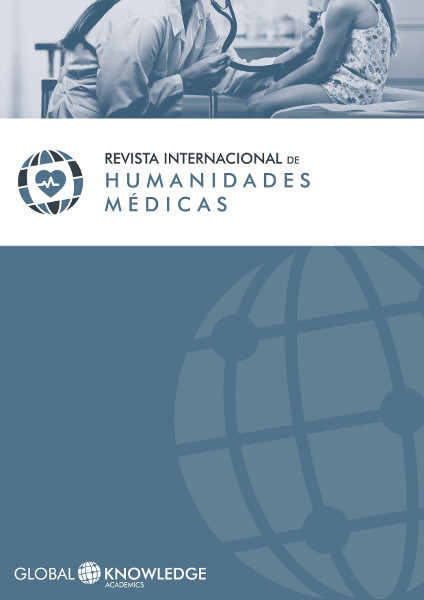Influenza A and the Role of the Media in a Pandemic: What Social Representations Create the Media about Health Epidemics?
DOI:
https://doi.org/10.37467/gka-revmedica.v3.1174Keywords:
Influencia A, Framing, Collective simbolic, Health PsychologyAbstract
This paper analyzes the social representations of the pandemic influenza A (H1N1) and their influence on the treatment made by the media during the crisis. The research takes as geosocial space analysis Mexico (where swine flu started) and Spain from March 2009 to August 2010. The analysis focused on the two general newspapers with the largest circulation in each country (El Universal and El País). This research intertwine two theoretical frameworks: Framing theory and the Colective Symbolic Coping (CSC) on social representations. The results show that the development of the health crisis influenced the use of key interpretive frames by the media, that launched the CSC process. Finally, the theoretical and applied implications of the interrelationship between the two theoretical perspectives used in the workplace are discussed.
Global Statistics ℹ️
|
102
Views
|
29
Downloads
|
|
131
Total
|
|
References
Altheide, D. (2010). Risk communication and the discurse of fear. Catalan Journal of Communication y Cultural Studies, 2 (2), 145-158.
Ann, S.K. y Gower K. (2009). How do the news media frame crises? A content analysis of crisis news coverage. Public Relations Review , 35 , 107–112.
Bartlett (1932). Remembering . Cambridge: Cambridge University Press.
Bauer, M. W. (2000). Science in the media as cultural indicator: Contextualizing surveys with media analysis. En M. Dierkes y C. Von Grote (Eds.), Between understanding and trust: the public, science and technology (pp. 157–178) Amsterdam: Routledge.
Bauer, M., Gaskell, G. y Durant, J. (2001). The years of controversy: Biotechnology 1996-1999. London: Museum of Science and Industry.
Beck, U. (2002). La sociedad del riesgo global. Madrid: Siglo XXI de España Editores.
Beck, U. (2006). La sociedad del riesgo: hacia una nueva modernidad. Barcelona: Paidós Ibérica.
Chan, M. (2009). El nivel de alerta de pandemia de gripe se eleva de la fase 5 a la fase 6. Recuperado el 14/03/12 de http://www.who.int/mediacentre/news/statements/2009/h1n1_pandemic_phase6_20090611/es/index.htm.
Cho, S. y Gower, K. K. (2006, junio). The Effect of Framing on Public’s Perception of Crisis: Human Interest Frame Effect on Attributions to Responsibility and Blame. Trabajo presentado en Annual meeting of the International Communication Association, Dresden, Alemania.
Davison, J., y Pennebaker, J.W. (1996). Social psychosomatics. En: E.T Higgins y A.W. Kruglanski (Eds.), Social psychology: Handbook of basic principies (pp. 102-132). New York: Guilford Press.
De Vreese, C.H. (2005). News framing: Theory and typology. Document Design, 13 (1), 51-62.
Entman, R. (1993). Framing: Toward Clarification of a Fractured Paradigm. Journal of Communication, 41, 51-58.
Faridah I., Normah M. y Chang P. (2010, junio). Framing a pandemic: analysis of malaysian mainstream newspapers in the h1n1 coverage. Trabajo presentado en International Communication Association 2010 Preconference – Health Communication Campaigns: Issues and Strategies in Asia, Australia and Southeast Asia. Singapur.
Gilles, I., Bangerter, A., Clemence, A., Green, E.G.T., Krings, F., Mouton, A., Rigaud, D., Staerkle, C. y Wagner-Egger, P. (2011). Collective symbolic coping with disease threat and othering: A case study of avian influenza. British Journal of Social Psychology, 52 (1) 83-102. DOI:10.1111/j.2044-8309.2011.02048.x
Goffman, E. (1974). Frame Analysis: An Essay on the Organization of Experience . New York: Harper y Row.
Gonzalo J.L. y Farré, J. (2011). Teoría de la comunicación de riesgo . Barcelona: Editorial UOC.
Igartua, J. J., Humanes, M. L., Muñiz, C., Cheng, L. Mellado, C., Medina, E. y Erazo, M. A. (2004). Tratamiento informativo de la inmigración en la prensa española y opinión pública. En A. Verano (Comp.), Setenta años de periodismo y comunicación en América Latina. Buenos Aires: Ediciones Universidad de La Plata.
Iyengar, S. (1990). Framing responsability for political issues: The case of Poverty. Political Behavior, 12 (1), 19-40.
Iyengar, S. y Kinder, D. R. (1997). News that matters: Television and American public opinion. Chicago: University of Chicago Press.
Joffe, H. (1999). Risk and the “other”. Cambridge: Cambridge University Press.
Kenix, L.J. (2008). From media frame to social change? A comparative analysis of same-sex rights in the United States and New Zealand press. Australian Journal of Communication , 35 (3), 105-128.
Klein, O., y Licata, L. (2003). “When group representations serve social change: The speeches of Patrice Lumumba during the Congolese decolonization”. British Journal of Social Psychology, 42, 571–593.
Kosicki, G. M. (2001). The media priming effect: News media and considerations affecting political judgments. En J. P. Dillard y M. P. Pfau (Eds.), The persuasion handbook: Developments in theory and method (pp. 63-81). Thousand Oaks, CA: Sage Publications.
McCombs, M. (2006). Estableciendo la agenda. El impacto de los medios en la opinión pública y en el conocimiento. Barcelona: Paidòs Comunicación.
McCombs, M., Lopez-Escobar, E. y Llamas, J. P. (2000). Setting the agenda of attributes in the 1996 spanish general election. Journal of Communication, 50 (2), 77-92.
McCombs, M.E. y Shaw, D.L. (1972). The Agenda-Setting Function of Mass Media. Public Opinion Quarterly, 36, 176-187.
Moscovici, S. (1988). Notes towards a description of social representations. European Journal of Social Psychology, 18, 211–250.
OMS (2009). Recurso a órganos consultivos por la OMS en su respuesta a la gripe pandémica (Nota informativa Nº 19) Recuperado el 14/03/12 de http://www.who.int/csr/disease/swineflu/notes/briefing_20091203/es/index.html.
OMS (2010). Respuesta internacional a la pandemia de gripe: la OMS responde a las críticas. (Nota informativa Nº 21). Recuperado el 14/03/12 de http://www.who.int/csr/disease/swineflu/notes/briefing_20100610/es/index.html.
Orr, E., Sagi, S., y Bar-On, D. (2000). Social representations in use: Israeli and Palestinian high school students´collective coping and defence. Papers on Social Representations-Online, 9, 2.1-2.20 (http://www.swp.unilinz.ac.at/content/psr/index.htm).
Pan, Z. Kosicki, G. (2001). Framing as Strategic Action. En S.Reese, O.Gandy, A.Grant, (eds.), Framing Public Life: Perspectives on Media and our understanding of the social world (pp. 35-66). Mahwah: Lawrence Erlbaum.
Pan, Z. Kosicki, G. (2005). Framing and the understanding of citizenship. En S. Dunwoody, L B. Becker, G. M. Kosicki, y D. M. McLeod (eds.), The evolution of key communication concepts (pp. 167-207). Cresskill: Hampton Press.
Reese, S. D., Gandy, Jr., O. H. y Grant, A. E. (2001). Framing public life: Perspectives on media and our understanding of the social world . Mahwah, NJ: Lawrence Erlbaum Associates.
Reinert, M. (1996). Alceste (Version 3.0). Toulouse: Images.
Rocamora Villena, V. (2012, enero). De la Comunicación de Riesgos a la Comunicación de Crisis. La OMS en el caso de la gripe A (H1N1). Comunicación presentada al III Congreso Internacional de la AE-IC “Comunicación y Riesgo”. Tarragona.
Rosenbrock, R., Dubois-Arber, F., Moers, M., Pinell, P., Schaeffer, D., y Setbon, M. (2000). The normalization of AIDS in Western European countries. Social Science and Medicine, 50, 1607–1629.
Scheufele, D. (2000). Agenda-setting, priming and framing revisited: Another look at cognitive effects of political communication. Mass Communication and Society, 3 (2-3), 297-316.
Scheufele, D. y Tewksbury, D. (2007). Framing, Agenda Setting, and Priming: The evolution of Three Media Effects Models. Journal of Communication, 57, 9-20.
Semetko, H. y Valkenburg, P. (2000). Framing European Politics: A Content Analysis of Press and Television News. Journal of Communication, 50 (2).
Setbon, M. (2000). The paradoxical normalization of AIDS. Revue Française de Sociologie, 41, 61–78.
Sperber, D. Wilson, D. (1986). Relevance-comunication and cognition. Oxford: Blackwell.
Valencia, J., Gil De Montes, L., Ortiz, G., Larrañaga, M. y Idoyaga, N. (2010). Enmarcamiento y el rechazo o aceptación de los aspectos generales y específicos de la Ley de igualdad de Género en España: representaciones sociales y regulaciones normativas. Revista de Psicología Social 25 (2), 145-155.
Valkenburg, P.M., Semetko, H. A. y De Vreese, C.H. (1999). The effects of news frames on readers’ thoughts and recall. Communications Research, 26, 550-569.
Vicente Mariñas, M. y López Rabadán, P. (2009). Resultados actuales de la investigación sobre framing: sólido avance internacional y arranque de la especialidad en España. ZER 26, 14-34.
Wagner, W. (1998). Social representations and beyond-brute facts, symbolic coping and domesticated worlds. Culture and Psychology, 4, 297-329.
Wagner, W., y Hayes, N. (2005). Everyday discourse and common sense: The theory of social representations. Basingstoke: Palgrave Macmillan.
Wagner,W., Kronberger, N., y Seifert, F. (2002). Collective symbolic coping with new technology: Knowledge, images and public discourse. British Journal of Social Psychology , 41, 323–343.
Downloads
Published
How to Cite
Issue
Section
License
Those authors who publish in this journal accept the following terms:
- Authors will keep the moral right of the work and they will transfer the commercial rights.
- After 1 year from publication, the work shall thereafter be open access online on our website, but will retain copyright.
- In the event that the authors wish to assign an Creative Commons (CC) license, they may request it by writing to administracion@edulab.es









